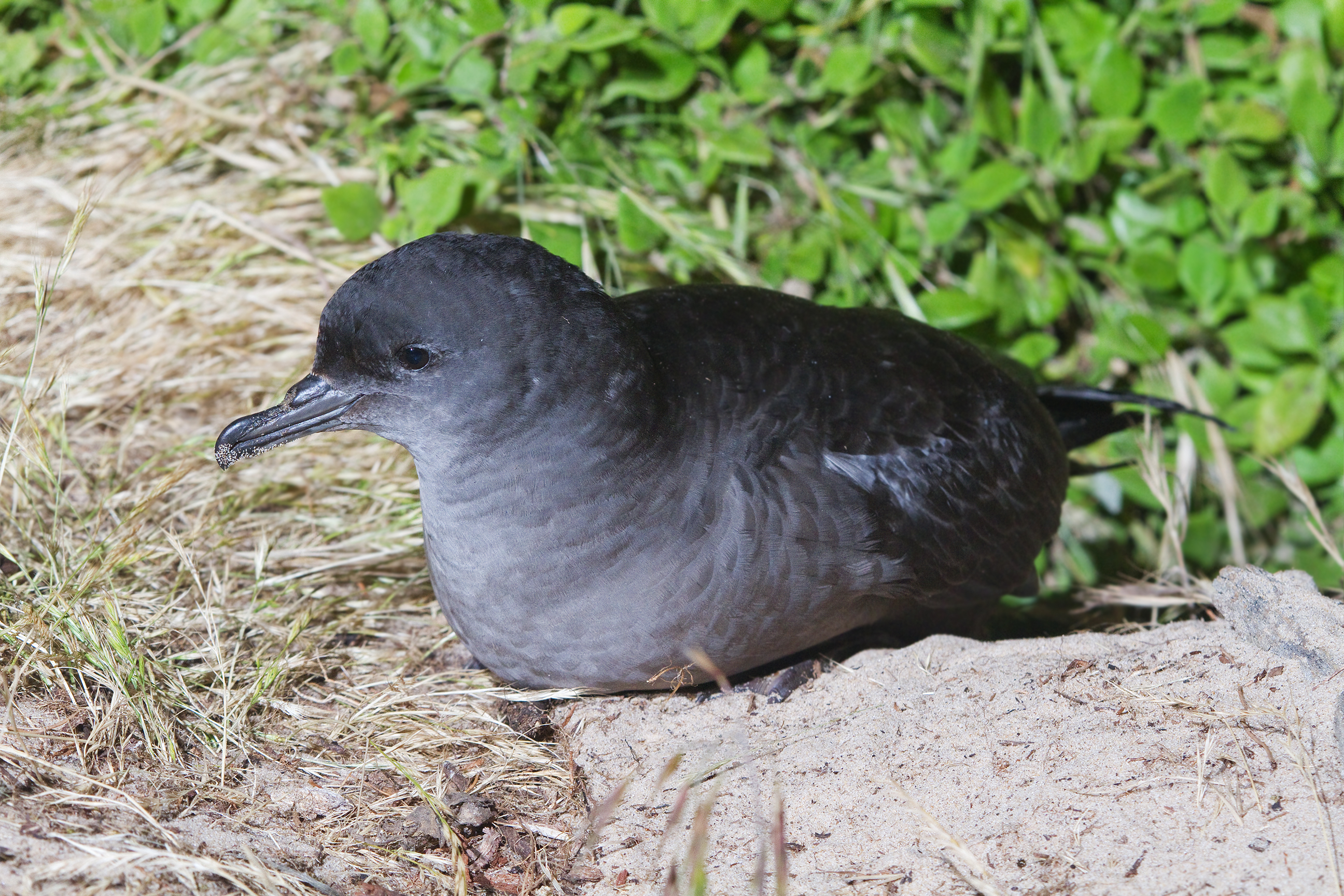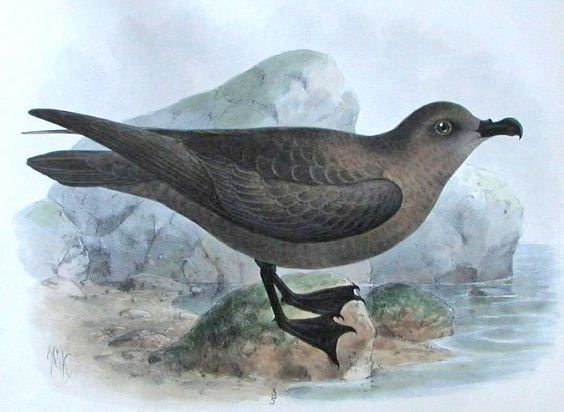|
Shearwaters
Shearwaters are medium-sized long-winged seabirds in the petrel family Procellariidae. They have a global marine distribution, but are most common in temperate and cold waters, and are pelagic outside the breeding season. Description These Procellariiformes, tubenose birds fly with stiff wings and use a "shearing" flight technique (flying very close to the water and seemingly cutting or "shearing" the tips of waves) to move across wave fronts with the minimum of active flight. This technique gives the group its English name. Some small species like the Manx shearwater are cruciform in flight, with their long wings held directly out from their bodies. Behaviour Movements Many shearwaters are long-distance migrants, perhaps most spectacularly sooty shearwaters, which cover distances in excess of from their breeding colonies on the Falkland Islands (52°S 60°W) to as far as 70° north latitude in the North Atlantic Ocean off northern Norway, and around New Zealand to as far as 60� ... [...More Info...] [...Related Items...] OR: [Wikipedia] [Google] [Baidu] |
Short-tailed Shearwater
The short-tailed shearwater or slender-billed shearwater (''Ardenna tenuirostris''; formerly ''Puffinus tenuirostris''), also called yolla or moonbird, and commonly known as the muttonbird in Australia, is the most abundant seabird species in Australian waters, and is one of the few Australian native birds in which the chicks are muttonbirding, commercially harvested. It is a migratory species that breeds mainly on small islands in Bass Strait and Tasmania and migrates to the Northern Hemisphere for the boreal summer. Taxonomy This shearwater appears to be related to the sooty shearwater, sooty and great shearwaters, which are also blunt-tailed, black-billed species, but its precise relationships are obscure (Austin, 1996; Austin ''et al.'', 2004). These are among the larger species of shearwater, which have been moved to a separate genus, ''Ardenna'' based on a phylogenetic analysis of mitochondrial DNA (Penhallurick & Wink, 2004). Ecology Each parent feeds the single chick fo ... [...More Info...] [...Related Items...] OR: [Wikipedia] [Google] [Baidu] |
Manx Shearwater
The Manx shearwater (''Puffinus puffinus'') is a medium-sized shearwater in the seabird family Procellariidae. The scientific name of this species records a name shift: Manx shearwaters were called Manks puffins in the 17th century. Puffin is an Anglo-Norman language, Anglo-Norman word (Middle English ''pophyn'') for the Curing (food preservation), cured carcasses of nestling shearwaters. The Atlantic puffin acquired the name much later, possibly because of its similar nesting habits. Taxonomy The shearwaters form part of the family Procellariidae, a widespread group containing nearly 100 species of medium to large seabirds. They have long, narrow wings and the characteristic “tube nose”. Although it was considered a monotypic species, recently an endemic subspecies for the Canary Islands has been proposed ''P. puffinus canariensis''. The large genus ''Puffinus'' includes several species formerly considered to be subspecies of the Manx shearwater, including the yelkouan shea ... [...More Info...] [...Related Items...] OR: [Wikipedia] [Google] [Baidu] |
Procellariidae
The family (biology), family Procellariidae is a group of seabirds that comprises the fulmarine petrels, the gadfly petrels, the diving petrels, the prion (bird), prions, and the shearwaters. This family is part of the bird order (biology), order Procellariiformes (or tubenoses), which also includes the albatrosses and the storm petrels. The procellariids are the most numerous family of tubenoses, and the most diverse. They range in size from the giant petrels with a wingspan of around , that are almost as large as the albatrosses, to the diving petrels with a wingspan of around that are similar in size to the little auks or dovekies in the family Alcidae. Male and female birds are identical in appearance. The plumage color is generally dull, with blacks, whites, browns and grays. The birds feed on fish, squid and crustacea, with many also taking Discards, fisheries discards and carrion. Whilst agile swimmers and excellent in water, petrels have weak legs and can only shuffle o ... [...More Info...] [...Related Items...] OR: [Wikipedia] [Google] [Baidu] |
Procellariiformes
Procellariiformes is an order (biology), order of seabirds that comprises four family (biology), families: the albatrosses, the Procellariidae, petrels and shearwaters, and two families of storm petrels. Formerly called Tubinares and still called tubenoses in English, procellariiforms are often referred to collectively as the petrels, a term that has been applied to all members of the order,Warham, J. (1996). ''The Behaviour, Population, Biology and Physiology of the Petrels''. London: Academic Press, or more commonly all the families except the albatrosses.Brooke, 2004. They are almost exclusively pelagic (feeding in the open ocean), and have a cosmopolitan distribution across the world's oceans, with the highest species diversity, diversity being around New Zealand. Procellariiforms are seabird colony, colonial, mostly nesting on remote, predator-free islands. The larger species nest on the surface, while most smaller species nest in natural cavities and burrows. They exhibit ... [...More Info...] [...Related Items...] OR: [Wikipedia] [Google] [Baidu] |
Sooty Shearwater
The sooty shearwater (''Ardenna grisea'') is a medium-large shearwater in the seabird family Procellariidae. In New Zealand, it is also known by its Māori language, Māori name , and is harvested by Māori people for muttonbirding, muttonbird, like its relatives the wedge-tailed shearwater (''A. pacificus'') and the Australian short-tailed shearwater (''A. tenuirostris''). Taxonomy The sooty shearwater was species description, formally described in 1789 by the German naturalist Johann Friedrich Gmelin under the binomial name ''Procellaria grisea''. The shearwater had been briefly described in 1777 by James Cook in the account of his Second voyage of James Cook, second voyage to the Pacific, but without a valid scientific name; and also in 1785 the English ornithologist John Latham (ornithologist), John Latham had described a museum specimen, again without giving it a scientific name. The sooty shearwater is now placed in the genus ''Ardenna'', that was described in 1853 by Ludwig ... [...More Info...] [...Related Items...] OR: [Wikipedia] [Google] [Baidu] |
Christmas Shearwater
The Christmas shearwater or ''aoū'' (''Puffinus nativitatis'') is a medium-sized shearwater of the tropical Central Pacific. It is a poorly known species due to its remote nesting habits, and it has not been extensively studied at sea either.Seto, N.W.H. (2001): Christmas Shearwater (''Puffinus nativitatis''). ''In:'' Poole, A. & Gill, F. (eds.): ''The Birds of North America'' 561. Academy of Natural Sciences, Philadelphia, PA & American Ornithologists' Union, Washington, D.C. (requires subscription) It is one member of a very ancient lineage of the small ''Puffinus'' species. Its only close living relative is the Galápagos shearwater (''P. subalaris''). Taxonomy The species was described and given its current binomial name by the American naturalist Thomas Hale Streets in 1877. A genetic analysis using mitochondrial DNA has shown that the closest living relative is the Galápagos shearwater (''Puffinus subalaris''). Description The Christmas shearwater is a slender-bo ... [...More Info...] [...Related Items...] OR: [Wikipedia] [Google] [Baidu] |
Petrel
Petrels are tube-nosed seabirds in the phylogenetic order Procellariiformes. Description Petrels are a monophyletic group of marine seabirds, sharing a characteristic of a nostril arrangement that results in the name "tubenoses". Petrels encompass three of the four extant families within the Procellariiformes order, namely Procellariidae (fulmarine petrels, gadfly petrels, diving petrels, prions, and shearwaters), Hydrobatidae (northern storm petrels), and Oceanitidae (austral storm petrels). The remaining family in Procellariiformes is the albatross family, Diomedeidae. Etymology The word ''petrel'' (first recorded in that spelling 1703) comes from earlier (''ca.'' 1670) ''pitteral''; the English explorer William Dampier wrote the bird was so called from its way of flying with its feet just skimming the surface of the water, recalling Saint Peter's walk on the sea of Galilee (Matthew xiv.28); if so, it likely was formed in English as a diminutive of Peter (< Old (?) ... [...More Info...] [...Related Items...] OR: [Wikipedia] [Google] [Baidu] |
Procellaria
Procellaria is a genus of Southern Ocean long-winged seabirds related to prions, and within the order Procellariiformes. The black petrel (''Procellaria parkinsoni'') ranges in the Pacific Ocean, and as far north as Central America. The spectacled petrel (''Procellaria conspicillata'') is confined to the Atlantic Ocean, and the Westland petrel (''Procellaria westlandica'') to the Pacific Ocean. The white-chinned (''Procellaria aequinoctialis'') and grey petrel (''Procellaria cinerea'') range throughout the higher latitudes of the Southern Ocean. Taxonomy The genus ''Procellaria'' was introduced in 1758 by the Swedish naturalist Carl Linnaeus in the tenth edition of his ''Systema Naturae''. The name is from the Latin ''procella'' meaning "storm" or "gale". The type species was designated as the white-chinned petrel by George Robert Gray in 1840. The genus ''Procellaria'' is within the Procellariinae clade, which includes the Shearwaters (a monophyletic group comprising ... [...More Info...] [...Related Items...] OR: [Wikipedia] [Google] [Baidu] |
Laysan Albatross
The Laysan albatross (''Phoebastria immutabilis'') is a large seabird that ranges across the North Pacific. The Northwestern Hawaiian Islands are home to 99.7% of the population. This small (for its family (biology), family) gull-like albatross is the second-most common seabird in the Hawaiian Islands, with an estimated population of 1.18 million birds, and is currently expanding (or possibly re-expanding) its range to new islands. The Laysan albatross was first described as ''Diomedea immutabilis'' by Walter Rothschild, 2nd Baron Rothschild, Lionel Walter Rothschild, in 1893, on the basis of a specimen from Laysan Island.Robertson, C. J. R. (2003) Etymology It is named for Laysan, one of its breeding colonies in the Northwestern Hawaiian Islands and the island where the type specimen was collected. The genus name, ''Phoebastria'', comes from Greek ''phoibastria'', meaning a prophetess. The species name, ''immutabilis'', is Latin for "unchanging" and refers to the similarity of im ... [...More Info...] [...Related Items...] OR: [Wikipedia] [Google] [Baidu] |





